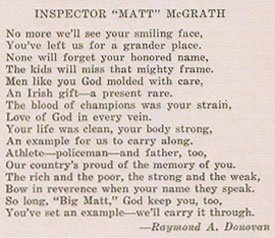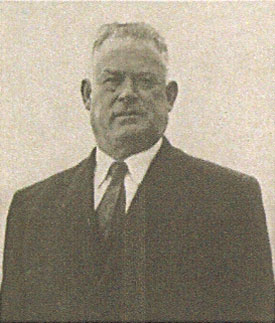All content on this site, unless otherwise specified, is © Copyright Ian McGowan / Winged Fist Organization. Web Design Conrad Landais
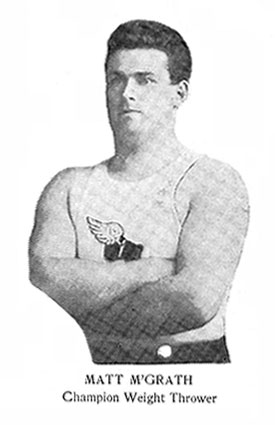
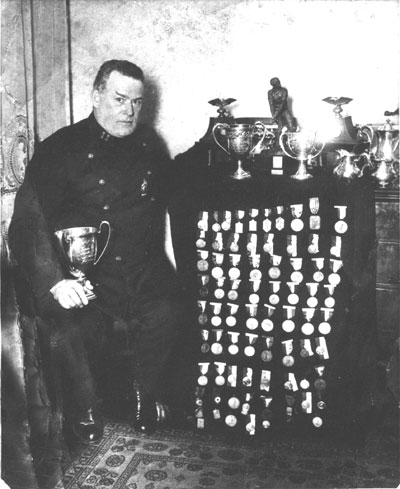
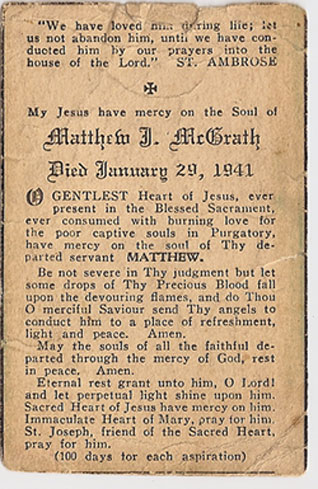
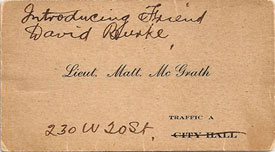
Matthew J. McGrath, through his mighty feats in American and Olympic arenas, proved himself one of the greatest weight throwers of all time. Born near the town of Nenagh in 1876, he departed for the United States while still in his ‘teens. As a youth in Tipperary he was known to walk ten miles to see “the father of modern hammermen,” John Flanagan, in action a Sports meeting, walk home again, and then immediately repair to a filed with an old-fashioned hammer, in an attempt to turn with it after the fashion of the Kilbreedy prodigy whom he had that day seen perform for the first time. A decade or more elapsed, however, before they rubbed shoulders on American soil in titanic struggles for supremacy.
The charge has frequently been made that some of the more outstanding weight throwers have been reluctant to pass on their knowledge to promising exponents of the younger school. The famous Pat Ryan of Pallasgreen states that whatever “knack” he had in hammer throwing he gradually acquired himself; nobody told him about it, and he believes Flanagan did not tell McGrath. It may be that Matt was left largely to his own devices, to lose a few valuable years as a result, for he definitely was slow to reach proficiency – much slower than his great contemporaries, Flanagan, Con Walsh and Pat Ryan – and had reached the age of 32 before winning his first Championship of the U.S.A.
America has never had, since or before, hammermen of the extraordinary power and ability of this group, this being all in favour of bringing out the real greatness of McGrath, when he got his bearings, and, such was the caliber of the opposition that he actually became a world record holder before taking his initial title.
Standing a fraction over 6’, and of massive proportions, he was not altogether as perfect in form as was Flanagan, but had a pronounced advantage over John in height and reach. Flanagan had been systematically breaking records from 1895 and had thrown 16lbs. hammer over the 170 feet mark from a 7’ circle, when, in 1907, Matt obliterated everything previously accomplished with an effort of 173’ 7” in the Canadian Championships at Montreal. In the London Olympiad the following year, Flanagan, after being second to McGrath, going into the final, came up to win with an Olympic record distance of 170’ 4 ¼”, Matt, the runner-up, being just short of 168’, with Walsh third. The American Championship, at Travers Island, in late September, saw Matt triumph over his famed adversary at 173’.
Flanagan, at Celtic Park, New York, on 6th June, 1909, again snatched the record with more than 174’, to which he added half a foot a week later at Travers Island. In 21st June, John threw 180’ in American League Park, this being the first time the classical mark had been reached by a human in a proper competition. Matt answered with an exhibition of 183’ 8” at the Tipperarymen’s Games, Ulmer Park, New York, although an exhibition could not be entertained as a record, but the 5’ 9 ½” marvel that was John Flanagan amazed the athletic world, after close on two decades in competition, by accomplishing a phenomenal 184’ 4” in the Clan-na-Gael Games, New haven Connecticut, on 24th July, 1909. Matt was beaten 13ft. and Con Walsh almost 20ft. More than two years then passed before new ground was broken.
Throughout 1910, Flanagan kept chalking up figures worthy of a great champion, winning the Canadian Championship with a Dominion record reading 179’ 2 ½”, and doing close 181’ in the New York Championship, in September. Con Walsh was now in the ascendancy, being second in the latter event over 170’, and having shown 179’ 2” at Newark, with a slight fall of ground. An instance of the power of Walsh can be gleaned from the following. At the New York A.C. Games, Travers Island, in September, 1910, where Matt reached 16’ 4” in throwing the 56lbs. for height, he was beaten by a fraction over 16½’ by Walsh. McGrath threw with both hands and Walsh with one. Con won the hammer throw at almost 171’ the same day.
The American Championships were taken to New Orleans in 1910 and Matt won the hammer by 5ft. from Walsh, but Con turned the tables by winning the 56lbs. laurels from McGrath and Pat McDonald, beating 37’.
1911 saw some terrific duels between McGrath and Walsh, John Flanagan having returned to Ireland. At Travers Island, in June, Matt threw the hammer 172’ and Con 170’ and form would seem to indicate that the Tipperary man was favourite for the American Championships, held on Forbes Field, Pittsburgh, but Con Walsh, who hailed from Carriganimma, Macroom, Co. Cork, landed his hammer out to an American Championship record of 177’ 6 ½”, to beat Matt by 4ft.
From this particular stage the finest hammer throwing of McGrath’s career was seen. At Celtic Park, on 20th August, 1911, he threw 179’ 3” and, on 26th, 177’ 6” at the same venue. On 23rd September, he smashed Flanagan’s Canadian record, going on 182’ 4” at Montreal and, on 22nd October, in the Fall Games of the Irish-American Athletic Club, New York, with the ground covered with slush, got in the amazing throw, allowing or the wretched conditions, of 180’ 9”. A week later he obliterated Flanagan’s world figures by exactly 3ft. with 187’ 4” in the Games of the Galwaymen’s Association, Celtic Park. Matt, who more than once was denied record through technicality, took no chances here. Achieving these unprecedented figures in his first attempt, and fearing the wire handle might possibly stretch in succeeding throws, to make the over-all length of the implement over the stipulated 4ft. he handed over the hammer to a member of the American Athletic Union Committee who happened to be on the ground and took no further throws. Pat Ryan beat this performance two years later but then Pat was the only one who ever beat the mark in an American arena.
McGrath still holds world records for throwing 56lbs. 40’ 6 ⅜” from a 7’ circle, and 33’ 1” from a stand, using both hands in each case. He also had a best on the books of 16’ 6 ¼” slinging a 56lbs. for height against a board, being superseded by Pat Donovan.
The year 1912 saw him win his Olympic laurels with 179’ 7 ⅛”, at Stockholm, in his first throw, beating John Flanagan’s Olympic high water mark by over 9ft., this being an unbroken best in the Olympics down to 1936, when Karl Hein of Germany beat 185’ at Berlin.
No Olympiad was held in 1916 owing to the First World War and Matt was relegated to firth place in the Antwerp Games of 1920 through a knee injury, Pat Ryan being an easy winner, although but 3ft. divided them, in favour of Ryan, in the American Olympic trials.
Following Ryan’s retirement, after winning the American title of 1921, Matt was still to the fore, and placed second to Freddie Tootell, U.S.A., in the 1924 Olympiad, with 167’. Matt was not selected to represent the U.S.A. in the 1928 Olympics, but quite a few of Uncle Sam’s sports writers contend he should have been, for points were won there down to 153’ odd.
McGrath never passed up an opportunity of visiting the homeland and, at Nenagh, in 1908, threw the hammer 176’ from a 9’ circle, the ground and measurements being certified by Mr. Robert P. Gill, Civil Engineer.
The “Freeman’s Journal” Sports of 1912 were to have Matt as a competitor but inclement weather caused a postponement and, three days later, a special meeting was arranged for Jone’s Road ground to enable the Nenagh Hercules to exhibit before Dublin enthusiasts, as he was anxious to do. Rain fell incessantly and in treacherous ground he threw the hammer 162’. The Tailteann Games, 1924, again brought Matt to Dublin and he won the hammer throw without being extended.
A keen student of physical culture, his grand physical condition kept him in Championship class for such a lengthy period of time that it contravened all laid down standards. As the years and the decades went rolling by it was extraordinary indeed to see him, fast graying and with an over-abundance of waist line, beating, time and time again, the pride of the Universities of the New World, trained to a hair. He won Championships of America with both hammer and 56lbs. in 1925, and the hammer title of 1926, this latter when he was 50 years old. He was an active competitor right up to 1934, taking the circle, although unsuccessfully, for the American 56lbs. laurels, when he was almost 58.
Matt McGrath rose to a high rank in the New York Police Force and was in charge of one of the key traffic stations of that City where his humane and gentlemanly treatment of subordinates made him endeared to all. He died on 29th January, 1941, being a perfect specimen for his years up to 12 months before when he contracted cancer of the liver, which brought about his untimely end. Many of the Irish population of New York have cause to mourn his loss, just as many emigrants, down at heel, had reason to pray for this stalwart son of Tipperary on affording them a fresh start in life through his unrivalled popularity and influential standing.
Had not war intervened, Matt may have been amongst us once again, for, in 1938, when considering retiring from police life, he expressed the wish to his great friend, Peter O’Connor, of Waterford, the old Olympic Champion, then in America, to reside in Dublin or Tipperary when freed from the strife and turmoil of the second City of the Universe. But it was not to be. Matthew J. McGrath, a Champion of Champions, who strode through International weight throwing arenas with a kingly mien, and proved one of our very finest Ambassadors, won 14 American and 1 Olympic Championship.
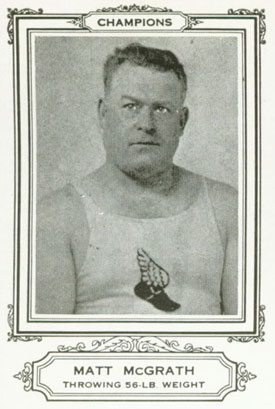
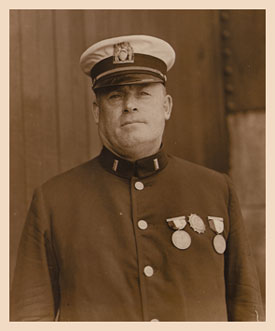
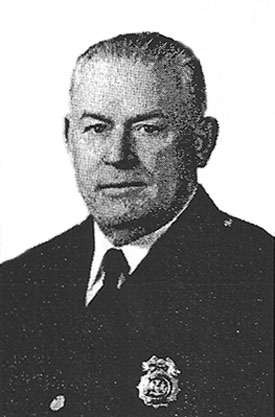
The following article is excerpted from Champions of the Athletic Arena, by William Dooley.
(For a printer friendly, Acrobat PDF version of this article, click here).
Champion weight thrower Matt McGrath was a lifelong member of the New York Athletic Club, and an honorary lifetime member of the Irish-American Athletic Club. While he normally competed as a member of the NYAC, he frequently associated with fellow Irish weight-men of the I-AAC, and was part of the collective known as the Irish Whales. McGrath served with the New York City Police Department from 1902 until his death in 1941, having attained the rank of Inspector, the third highest in the Police Department. He was awarded the NYPD’s Medal for Valor twice. For both his athletic prowess, and his rank in the NYPD, a contemporary sports writer dubbed him “The Prince of Whales.”
